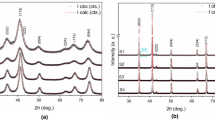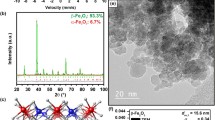Abstract
On the basis of X-ray identification and studies of magnetic properties, it has been found that coprecipitated hydroxides of iron(III) and zinc(II) transform, after being boiled in distilled water, into a mixture of hydrated oxides, the ferromagnetic modification of iron(III) oxide,π-Fe2O3, being responsible for the ferromagnetic behaviour of the mixture. The highest specific magnetization value is obtained for the stoichiometry ZnO: Fe2O3=0.275: 0.725.
Since for spinel stoichiometry, Zn(OH)2/2 Fe(OH)3, the magnetic property drops to near zero, formation of zinc ferrite cannot be excluded. However, the poor crystalline shape of this phase, as usually happens when the technique adopted here is involved, does not allow direct confirmation of the existence of that phase by diffraction methods.
Résumé
L'identification aux rayons X et l'étude des propriétés magnétiques montrent que les hydroxydes coprécipités de fer (III) et zinc (II) se transforment, après ébullition dans l'eau distillée en un mélange d'oxydes hydratés, la modification ferromagnétique de l'oxyde de fer (III),π Fe2O3 étant responsable du comportement ferromagnétique de ce mélange. On obtient la valeur la plus élevée de la magnétisation spécifique pour le rapport stoechiométrique ZnO ∶ Fe2O3=0.275 ∶ 0.725.
Etant donné que pour la stoechiométrie du spinelle: Zn(OH)2/2 Fe(OH)3, le ferromagnétisme tombe à une valeur proche de zéro, on ne peut pas exclure la formation de ferrite de zinc. Cependant, la forme mal cristallisée de cette phase, obtenue généralement, ne permet pas de confirmer directement l'existence de cette phase par les méthodes de diffraction.
Zusammenfassung
Aufgrund von röntgenographischen Untersuchungen und von magnetischen Messungen wurde festgestellt, daß die beim Kochen gemeisam gefällter Hydroxide Zn(OH)2/Fe(OH)3 im Wasser entstehenden hydratisierten Oxide ferromagnetische Eigenschaften besitzen, die durch Anwesenheit von π-Fe2O3 bedingt sind.
Die höchste spezifische Sättigungsmagnetisierung weist ein Präparat mit einer Stöchiometrie ZnO ∶ Fe2O3=0.275 ∶ 0.725 auf.
Bei spineller Stöchiometrie: Zn(OH)2/2 Fe(OH)3, fallen die magnetischen Eigenschaften bis in die Nähe des Nullwertes herab. Man kann daher die Entstehung von Zinkferrit nicht ausschließen. Eine eindeutige röntgenographische Bestätigung dieser Phase ist durch die schlechte kristalline Form dieser Phasen, welche meistens bei einer solchen präparativen Technik entstehen, nicht möglich.
Резюме
На основании рентген о-диффракционного исследования и изуче ния магнитных свойств, было найдено, что соосажденные гид роокиси железа(Ш) и цинка(II) посл е нагревания до кипения в дестилли рованной воде превра щаются в смесь гидроокисей, со держащих ферромагнитную моди фикацию окиси железа (Ш), γ-Fe2O3, которая ответственн а за ферромагнитные св ойства этой смеси. Наи более высокое значение уде льного намагничиван ия получено для стехиом етрического состава ZnO: Fe2O3=0.275: 0.725. Поскольку стехиометрический с остав шпинели: Zn(OH)2/2Fe(OH)3 и магнитное свойство к оторой почти падает до нуля, т огда не может быть иск лючено образование феррита цикла. Однако, слабо выраженная кри сталличность этой фа зы, не позволила прямо подт вердить методом диффракции образова ние феррита цинка.
Similar content being viewed by others
References
H. Forrestier andJ. Longuet, Compt. Rend., 208 (1939) 1729.
T. Takada andM. Kiyama, ICF*, 6A1. 1, 1970.
V. Chalyi, Ukr. Khim. Zh., 25 (1959) 285.
W. Wolski andU. Politanska, Zh. Prikl. Khim., 38 (1965) 667.
W. Wolski, Monatsh. Chem., 104 (1973) 1276.
U. Schwertmann andW. Fischer, Z. Anorg. Allgem. Chem. 346 (1966) 137.
U. Schwertmann, Z. Anorg. Allgem. Chem. 298 (1959) 337.
Author information
Authors and Affiliations
Rights and permissions
About this article
Cite this article
Wolski, W., Kaczmarek, J. Thermal transformations of the originally amorphous Zn IIX Fe III1−X (OH)3−X system. Journal of Thermal Analysis 17, 495–500 (1979). https://doi.org/10.1007/BF01914038
Received:
Published:
Issue Date:
DOI: https://doi.org/10.1007/BF01914038




